12 Most innovative composting systems
by: Ecofriend, 2011-06-14 04:45:44 UTC
Wrik Sen:

Innovative composting systemsComposting revitalizes your soil with necessary vitamin and minerals, serves as a fertilizer to the fruits and vegetables in your garden, and also acts as a natural pesticide.
Composting, in simplest terms is the process of creating a natural fertilizer from decomposed food and plant matter. An essential component of organic farming, this fertilizer and natural pesticide can be made by recycling everyday food and plant matter which are otherwise disposed of without much productive use. This list provides a glimpse into some of the most innovative composting systems, and their specialties.
1) Biophyllic Composting System:

Biophillic Composting SystemBiophillic Composting System designed by Cooler Solutions Inc, is based on the concept of Biophillia, the instinctive bond between humans and other living systems.
Research has shown that close to 33% of the waste material from offices, are organic waste which are perfect capable of being reused into something ecologically friendly such as compost. Hence, with the system all the waste from offices are collected, sorted and then put into a compost bin, the product of which is used to grow smaller plants inside those offices. This creates a healthier environment for the office users, and creates a building with sufficient oxygen supply within the building.
2) The Bokashi Bucket:

The Bokashi BucketThe Bokashi Bucket is a practical and convenient alternative for transforming kitchen waste into a nutrient rich soil conditioner.
Bokashi in Japanese translates into ‘fermented organic matter’. A common form of composting used in the Asian country, this process involves the layering of waste organic matter, and a special Bokashi mix till the concerned bin is filled. The Bokashi mix is added to ensure that the contents inside do not give out a foul odour which could occur otherwise. After filling the bucket, it is kept aside for about a week, after which the ‘juice’ produced from the composting is taken out from the tap located below the Bokashi bucket and used as a liquid fertilizer on plants. Also, the solid residue inside the bucket could be mixed with soil and used with plants.
3) Can-O-Worms Worm Composter

Can-O-Worms Worm ComposterThe Can-O-Worms is an odorless, user-friendly worm composting system that allows anyone to participate in recycling and garden enrichment through composting.
When one thinks earthworms, the feeling isn’t always pleasant but taking into account how useful they can be, they are certain worth rearing. Using a process called vermiculture; earthworms are reared in a device which looks like a worm condo, with layers and rings of worms in them. This odorless system of garden enrichment essentially involves growing worms inside the ‘worm condo’, and collecting the rich deposits left by these worms and mixing the same with the soil of plants and trees. The deposits are extremely rich in nutrition essential for plant growth, thus acting like a fertilizer for the soil. The worms and their condo have to be bought separately but once done, can provide a high quantity of natural fertilizer for organic farming. The added advantage is that this process can be undertaken whether in an apartment building or even individual housing.
4) Worm Bins Vermicomposting Systems

The Worm WigwamThe Worm Wigwam is designed to process large amounts of food and organic waste and never needs to be emptied or restarted, using 100% of the composting area.
Essentially constructed as a process to convert a sizeable amount of organic waste, within a limited span time, these bins are to be fed with the raw material using the top portion. After that, one has to churn the lever on the side and in due time, a large quantity of organic fertilizer gets produced, without the presence of earth worms. Mainly meant for small scale composting, this device is much less labor intensive and saves time in the process of compost making.
5) Naturemill Composter

Naturemill ComposterThe Naturemill composter is the ideal way to get your gift recipient churning out their own rich soil easily and with no odor.
If you are short of innovative gifts for someone with tastes in organic farming, then this composting system device is the answer. Slim in design, the device fits easily inside a kitchen cabinet or in a small part of a covered balcony. Totally odorless as claimed, the mixture and production of nutrition rich fertilizer is produced automatically on feeding the essential ingredients into the machine, and the product can then be collected to be used in plants and trees.
6) Envirocycle Composter

Envirocycle ComposterEnvirocycle Composter is easier to handle and easier to turn the drum for effortless rotation, with approximate 120 to 156 degrees interior temperature this home composter is perfect for garden lawn and kitchen refuse.
A hassle free compost making procedure, this activity involves the collection of organic waste like food and plant matter into the rolling drum of the device, and in 4 to 6 weeks, a rich and nutritious plant fertilizer is ready to be used. To dump the fertilizer directly onto the spots, one had to latch and roll the device till the chosen area and then by undoing the latched door, the total contents can be then be spread out on the surface. Due to a compact design, it is a perfect device to have for one’s kitchen gardens and lawns.
7) Kitchen Compost Bin

Kitchen Compost BinThe Kitchen Compost Bins are portable and perfect for short term storage of kitchen compost that was designed with home composting programs in mind.
Resembling a simple kitchen bin, these kitchen compost bins are meant for home compost projects. Easy to clean and refurbish, these bins need the organic waste to be fed through the top lid on the bin, and then allowed to decompose for a weeks, after which it would be ready for use in the gardens and lawns. Due to this lightweight design, it fits well into kitchens or simply hung on the kitchen wall with the help a couple of screws. Also, the special carbon filter keeps out the general foul odors of decomposition.
8) Indoor Kitchen Composter

Indoor Kitchen ComposterThe Indoor Kitchen Composter is the indoor home composting system you need to to recycle kitchen waste into organic soil fertilizer.
Stylish and sleek, this kitchen composter is another option for home composting activities. Best used by decomposing organic waste under no oxygen, this device helps create organic fertilizer in close to half the time taken by other composting devices. Due to the compactness of design, it fits perfectly under the kitchen sink or cabinets, and could be very handy for those living in apartments.
9) Mantis ComposT-Twin Garden Compost Bins

Mantis ComposTThe Mantis ComposT bins are fully enclosed and elevated to keep rodents, pets and other wildlife out.
A device meant to ease composting in homes, especially apartments, constitutes 2 chambers where the rich and nutrition rich fertilizer is made. All one needs to do, is feed the raw material into one of the chambers, and churn the bin with the help of the lever attached alongside and in due time, a sizeable quantity of fertilizer is ready for usage. Since the device is shut from all sides, it prevents most rodents and animals from getting to the decomposing raw material inside.
10) Earth Tub Composter

Earth Tub ComposterThe Earth Tub is a small scale, in-vessel composting system for recycling organic waste materials at the site where they are generated. Complete with a bio-filter for odor processing and control, this system provides a neighborhood friendly efficient comp
Mainly meant for schools, colleges, supermarkets, restaurants and hospitals, this on-site decomposer comes in a comparatively larger size as compared to the others mentioned in the list. This device has a top loading facility, where by essential raw material is put into the tub, and then the lid is shut tight. With the help of the rotating cover, the mixture is churned inside for while with the mixing auger, and after the final product is made, the unloading door on the side is opened to take the contents out. Also, there are vents on the sides which allow the appropriate mixing of air inside the tub, so that the fertilizer mixture can be prepared appropriately.
11) The Worm Inn

The Worm InnThe Worm Inn is a vermicomposting bag designed to facilitate the composting of food waste with the use of worms.
Essentially a woven bag on a PVC stand, this decomposer needs to be fed in the mixture of raw materials, which is food scraps and earthworms, before being zipped from the top. As worms consume the fresh materials of food inside the bag, they keep moving upwards leaving behind fresh casings of themselves. Over a period of time, after sufficient decomposition takes place, the mixture is taken out for use in the soil. Due to a ventilation system, the final mixture is extremely well developed and rich in nutrition. Also, after the process is complete, the bag can be taken out and cleaned with comparative ease.
12) Isis Indoor Composting System

Isis Indoor Composting SystemDealing with the in-home recyclablity issues in a fun self-contained unit, the ISIS Indoor Composting System encourages recycling and waste management of organic products in a residential setting without sacrificing user lifestyle.
Built on similar lines, of the home-based composting systems, this device comes in a compact shape, and produces rich organic fertilizers within a short span of time. Sleek in design, and the lower demand for space make it ideal for composting needs within apartment buildings, without compromising on the users’ lifestyle.


 How A Simple Text Message System Is Helping Latino Immigrants Save Serious Cash
How A Simple Text Message System Is Helping Latino Immigrants Save Serious Cash
by: fast company, 2011-06-13 14:59:32 UTC
Juntos Finanzas, a budget-by-text program started at Stanford with a group of janitorial workers, is part Mint.com, part Weight Watchers. Now it's making real changes in the lives of lower-income workers.

Saving money is hard for most people. But when you’re making a pittance to begin with, it’s easy to believe that there’s nothing to put away in the first place.
It's the situation a group of first-generation immigrants working as janitors at Stanford University found themselves in. So they joined forces with graduate students as part of a class at the d.school and came up with a budget-by-text system that is helping people in their same financial bracket tuck away thousands of dollars a year.
Juntos Finanzas, a new service geared specifically toward first-generation Latino immigrants, works a little like Mint, a little like Weight Watchers. Users log all their expenses by text message (since they tend not to have computers), and at the end of the month, Juntos sends them a paper chart, by mail, showing where all their money went.
That simple act, Juntos cofounder Ben Knelman tells Fast Company, has had a profound effect. In a six-month test, participants, who earn less than $40,000 a year, managed to save an average of $1,400.
“We’re not really doing anything that they couldn’t be doing on their own,” Knelman says. “But when we give the information back, it’s coming from a third party. It looks professional. That information feels more real. It makes you think, ‘This is something I need to be thinking about.’” (The importance of outside influence in making changes was documented in Fast Company writer Alan Deutschman's landmark article "Change or Die.")
During the test, one of the participants discovered he was spending over $200 a week on his child’s cellphone bills. He switched to a different plan, which inspired him to re-examine his cable and car insurance plans as well.
“We’ve flipped their thinking from ‘My money is gone because I don’t have enough’ to ‘I have space to make choices,’” Knelman says.
Juntos recently won first place in Stanford’s Social Entrepreneurship Challenge. The company, which was incubated by Stanford’s StartX accelerator, is putting the product into a beta test this summer. Eventually, it will become a business supported, Knelman says, either by advertising or by offering it as a white-label product to banks and credit unions.
Read also: Fast Company’s previous coverage of the Stanford d.school
[Image: Flickr user kenteegardin, courtesy of SeniorLiving.org]
E.B. Boyd is FastCompany.com's Silicon Valley reporter. Twitter. Email.


 Bill Gates Funds Human Waste To Biofuel Project In Ghana
Bill Gates Funds Human Waste To Biofuel Project In Ghana
by: fast company, 2011-06-13 19:08:54 UTC
Developing countries lack both clean water and clean energy sources. By converting soiled water into energy and clean water, a new project could wipe away both problems.

Waste to fuel facilities are nothing new--in the past few years, we've seen chicken poop-powered fuel cell plants, a scheme to use astronaut poop for fuel in space, and a town that's converting wastewater sludge into thermal energy. But now, occasional clean energy cheerleader Bill Gates is taking an interest in the technology--and that means it may start getting more attention.
The Bill and Melinda Gates Foundation recently awarded Columbia University professor Kartik Chandran a $1.5 million grant to develop a "Next-Generation Urban Sanitation Facility" in Accra, Ghana. The facility, which has not yet been built, will turn organic compounds from fecal sludge into biodiesel and methane (two energy sources).
Some 2.1 million city dwellers around the world depend on non-piped solutions to their sewage needs. That is to say, their waste is going into septic tanks, storage devices, or just being dumped directly into the water supply. All that fecal matter in the water--especially in places that also lack water treatment facilities--generates an incredible amount of waterborne illness.
If Chandran's project comes to fruition, it will both provide a cheap source of fuel in an energy-poor region and minimize the amount of fecal sludge that ends up in local bodies of water. "By training tomorrow’s engineers in sustainable approaches to ‘resource
and energy recovery’ rather than 'wastewater treatment,' a sea-change
can be achieved in the way we perceive of and manage human waste. In
fact, the term 'wastewater' is already archaic. Wastewater is, after
all, just water with a different chemical and biological composition," explained Chandran in a statement.
We'll probably hear about more human waste to biofuel plants in the developing world in the near future. And hopefully, that will at least begin to cut down on the 1.8 million people who die each year from water-transmitted diseases like cholera.
[Hat tip: CleanTechnica]
[Image: Flickr user jdn]
Reach Ariel Schwartz via Twitter or email.
Read More: Gates Foundation Invests $70 Million to Help Save World's Food Supply


 Top 25 Entries of Electrolux Design Lab 2011
Top 25 Entries of Electrolux Design Lab 2011
by: Yanko Design, 2011-06-13 16:00:49 UTC
Intelligent Mobility, Scandinavian Design Sensibilities and Existing Technologies were the key words for consideration while designing the Electrolux Design Lab entries for 2011. For booty of 5,000 Euros and six-months paid internship, thousands of designers set to the task of designing appliances that can be used at home and beyond. Looking at the shortlisted 25 entries it’s really hard to predict which one will wear the crown. Last year’s winner Peter Alwin pitched the bar up high with his Snail Concept; this year the competition gets tougher, so good luck designers!
Breeze Dish Air Dryer by Andrew Parsons
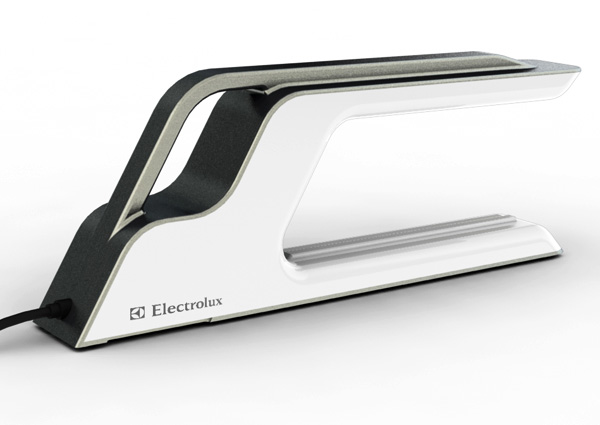
Breeze is a dish dryer meant for those households that don’t use a dishwasher. My side of the globe relies on hand washed dishes that are towel dried, so this concept kinda rings home true. The appliance uses an airblade with a digital pulse motor that beams out a thin strip of air for drying the dish as it passes under it.
Cooker EMS by Simona Hruskova
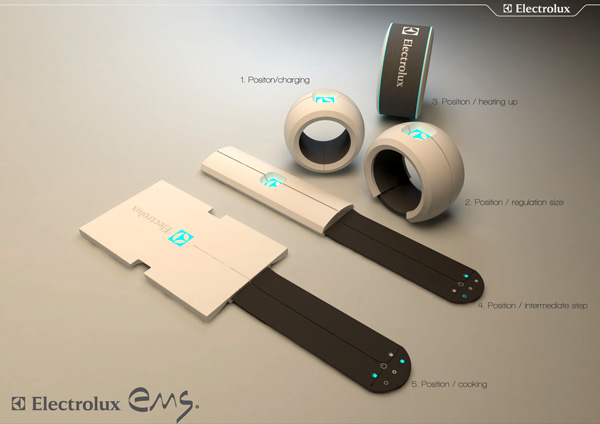
Cooker EMS has a bracelet kind of contraption that goes around your wrist and harnesses kinetic energy with your every movement. Unfurl the bracelet to use the kinetic heating plates to cook food or warm your coffee! The power of YOU!
EcoWash Dinner Set by David Stockton
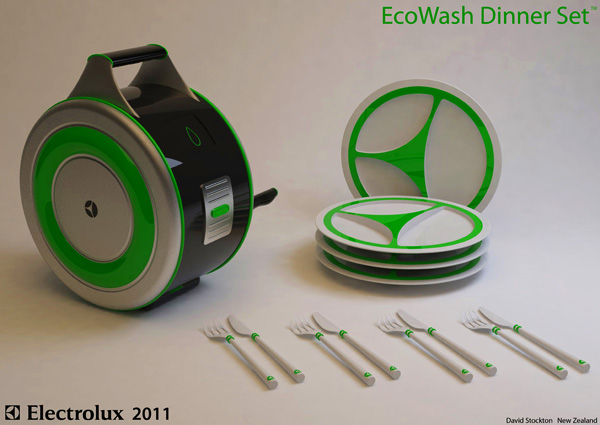
EcoWash is a portable dishwasher that works with a hand crank. A few good swirls gets the inner mechanism working to clean the dishes in an eco-friendly way. You can read the details on this project here.
Gull Air Purifier by Tomasz Siemek
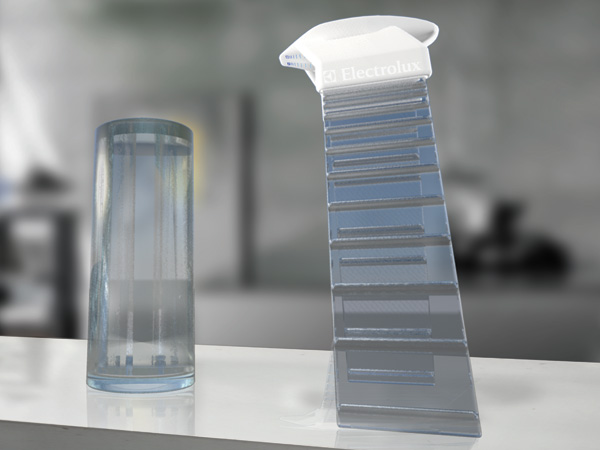
Gull is an air purifying system that uses lemon oils to cleanse the air. Inspired by a bird’s flight, the device uses kinetic energy to work its mechanism.
Heat Grenade by Sam Evans
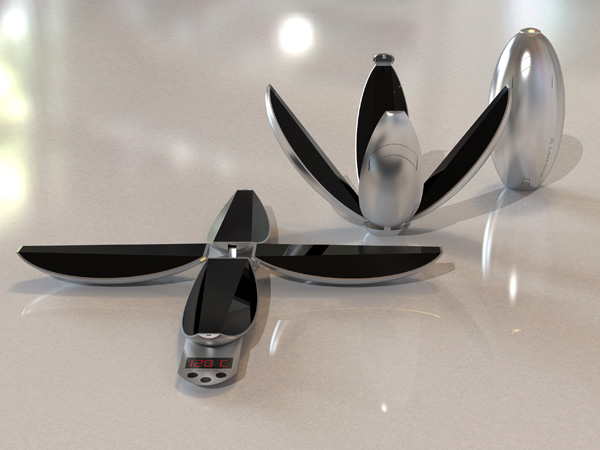
Heat Grenade is a simple induction-cooking platform for emergency situations, blackouts and outdoor cooking. As a closed structure the cooker hardly occupies any place, but once open its is big enough to hold a pot. It is powered by paper thin batteries made by Cenimat.
Honeycomb Modular Induction Tiles by Alfred Ching
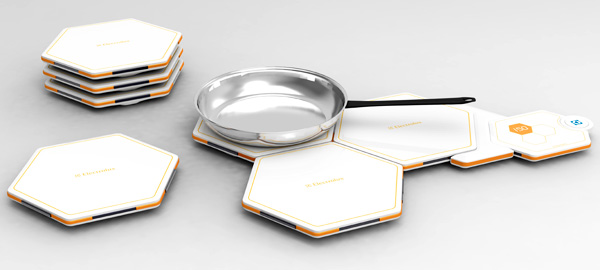
Honeycomb is a set of induction cooking tiles that can be expanded or detached, to suit your purpose. It hooks up with Bluetooth to the remote control, allowing you the freedom to change the settings from a distance.
Intelligent Mobility Scale Bag by Karel Vránek

Intelligent Mobility Scale Bag holds your goodies and keeps them cool. Expand it to use as a shopping bag for groceries or keep it compact with a drink and fruit inside!
Marbles by Eduardo Nauiack
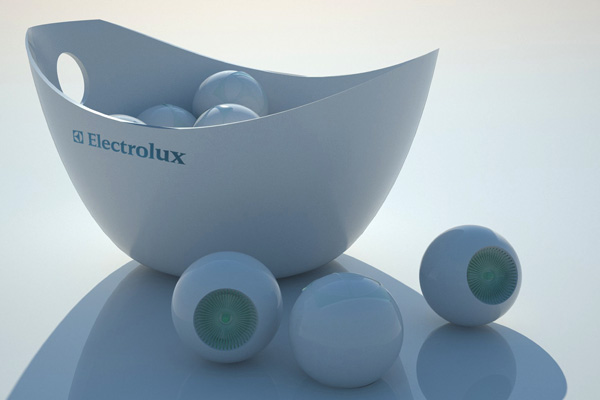
Marbles is a set of individual mixers that you throw into a bowl to work collectively as a blender. Knead dough, make juice or simply churn some milkshake. To increase the intensity of the mixing, just keep adding more ‘marbles’!
Mobile Induction Hot Plate by Tommi Moilanen
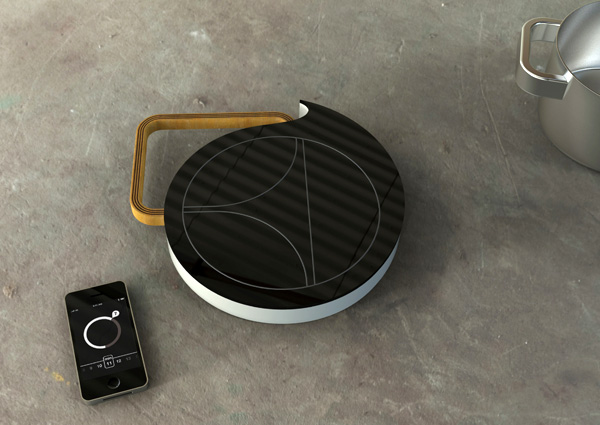
Keeping in times with the smartphone generation, the Mobile Induction Hot Plate can be controlled via Bluetooth and can be paired with your smartphone. It’s controlling app keeps recipes and adjusts the cooking time for your convenience. The portable cooker can be charged via induction, cable and batteries. A great appliance in all!
Mobile Kitchen Kit by Elizabeth Reuter
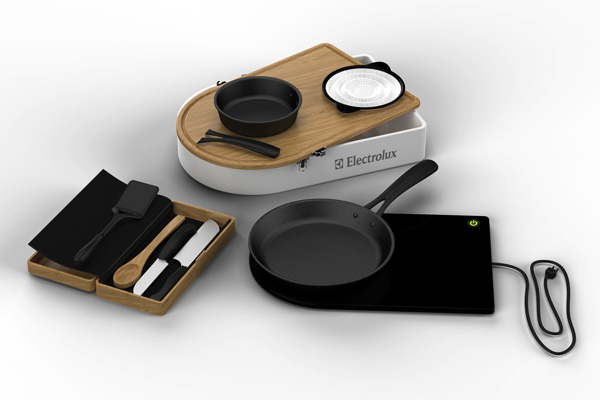
Cook from a box, literally! The Mobile Kitchen Kit includes a cutting board, flexible induction cooking pad, strainer, spatula, wooden spoon, cutting knife, peeling knife, skillet, saucepan and a strainer. All the tools that help you cook a variety of meals, even on the go!
Mohe by Krzysztof Luchowiec
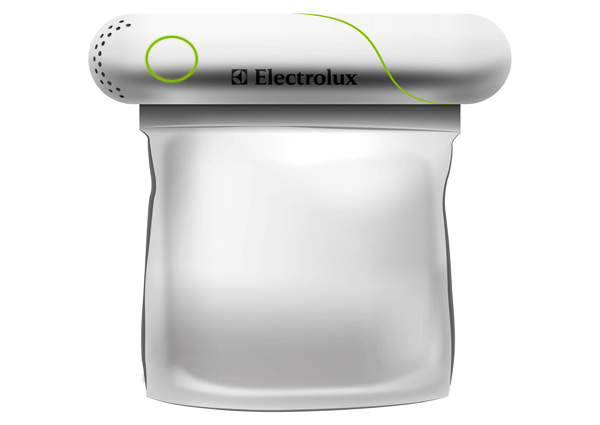
Mohe is a smart way of storing homemade food. The specialized pack can be vacuum-sealed and the package itself contains a thin layer of water activated exothermic chemical heater and an additional isolation layer. This is that you can reheat your food in the package itself, without getting your fingers burned! Hot homemade food on the go!
MyWash by Saba Zare
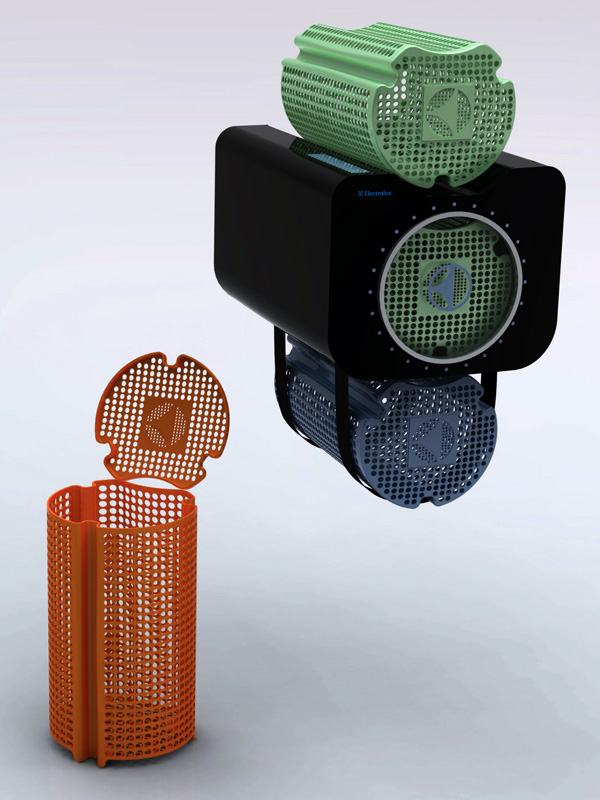
MyWash is a system where we stack the laundry basket above the washing machine and once the basket is full, it automatically empties into the wash-bin. A smartphone app notifies us that the load is ready and we can use the program apt for that particular cycle. What this system basically does is that it eliminates the need for manually loading the machine with a washload.
Onda by Matthew Schwartz
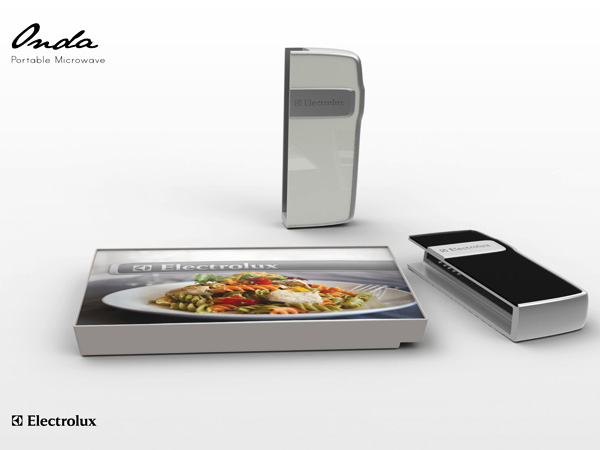
Onda is a portable microwave that works with a special compatible food container. It reheats food and is ideal for office.
Ozel Kinetic Mixer by Uzer Abdul Rashid
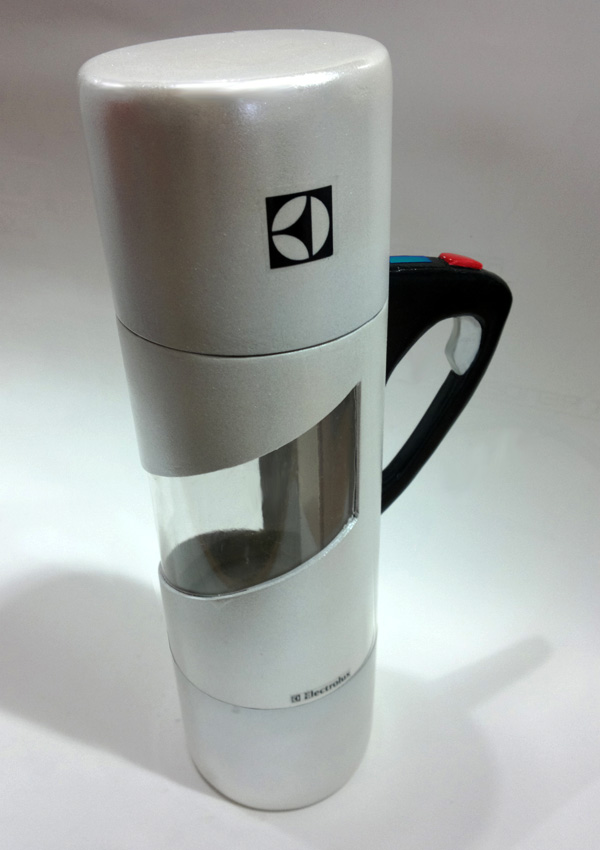
Ozel is a kinetic blender that blends in a jiffy. The handle of the jar is the main unit where the kinetic energy is stored. A few good revs powers up the unit and is ready to be used.
PingPong Kitchen Helper by Arthur Kenzo

PingPong and its bowl of sensors eliminate the need for the cook to be watchful over his dish. For example if you are boiling milk in a pot, just hook the Ping on its rim and carry the Pong to the next room, where some urgent task awaits you. Color sensors on the Pong warn you in time to return to the kitchen, before the milk boils over. Simple!
Portable Washing Machine by Adrian MankoveckÏ
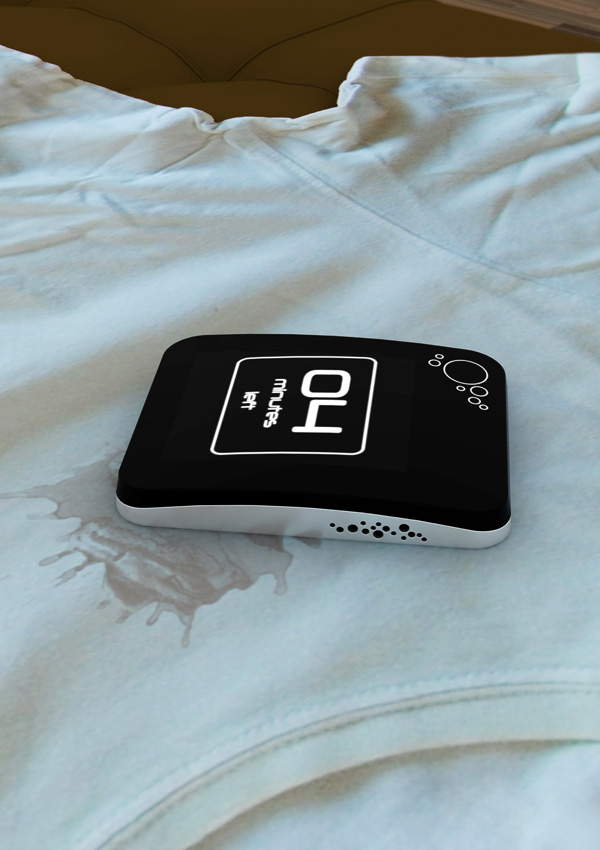
The Portable Washing uses a combination of steam and negative ions for the cleaning process and is powered by a high-density sugar battery. The washer is meant for target washing i.e. specific areas of the cloth…like a coffee stain or sweaty underarms of the shirt.
Ribbon by Enzo Kocak
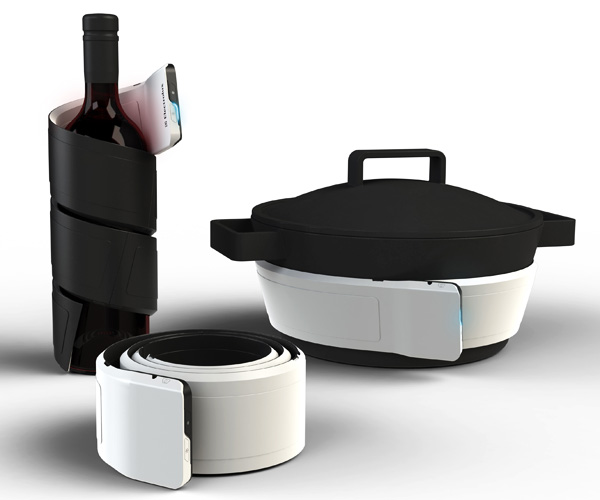
The Ribbon swings between being a warming and a cooling device for your food and beverage. Wrap the black lining to heat the dish or the white lining to chill a bottle of wine!
Ringoo by Jacek Chrzanowski
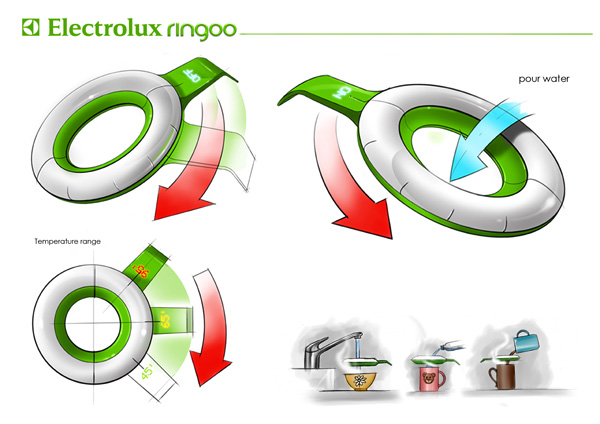
Ringoo is a portable microwave that is circular in shape for a reason. The loop in the ring holds the heating element and when water (or any other liquid) is poured through, it heats it up. Good enough to heat a precise cup of water for coffee!
Robo TAP Cleaner by Gyu Ha Choi
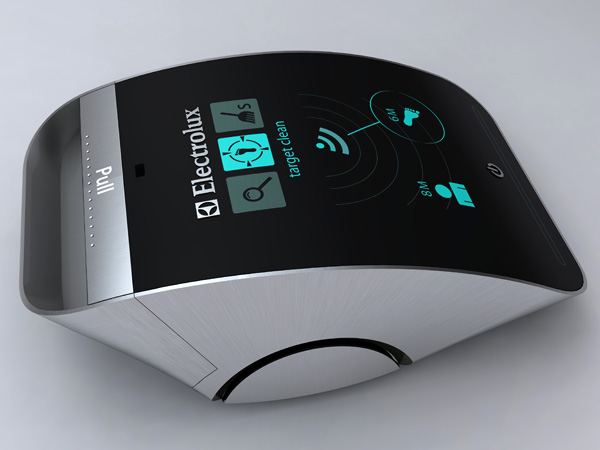
Robo TAP is a robotic vacuum cleaner that works in sync with a remote clip hooked onto the users shoe (or slipper). Coordinated taps by the foot indicate cleanup or cancelling of a cleaning command. Kind of a tap dance to get the cleaning done!
Salvé Bagel Toaster by Kent Madden
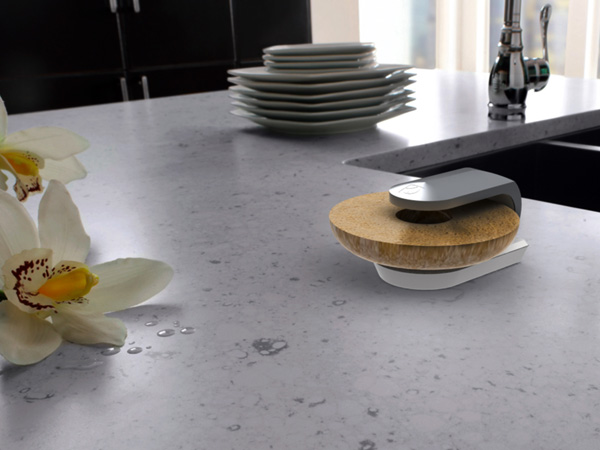
Bagel lovers who don’t find enough time to toast some, this one is just for you! The Salvé toasts bagels by rotating them under the heating element in a circular manner. Sugar Crystal Batteries power the toaster and an alternate of ceramic induction charging is also possible.
Smoobo Blender by Roseanne deBruin
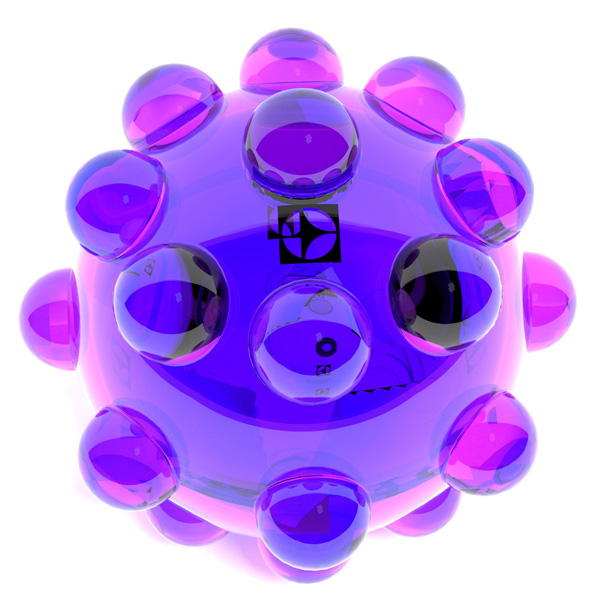
The new way to make smoothies is to bounce the Smoobo! The bouncy ball encloses a rotary blade that uses kinetic energy to work. Simply put in the ingredients and bouncy the blender to make a really cool thickshake!
Sous-vide Cell Cooker by Adam Miklosi
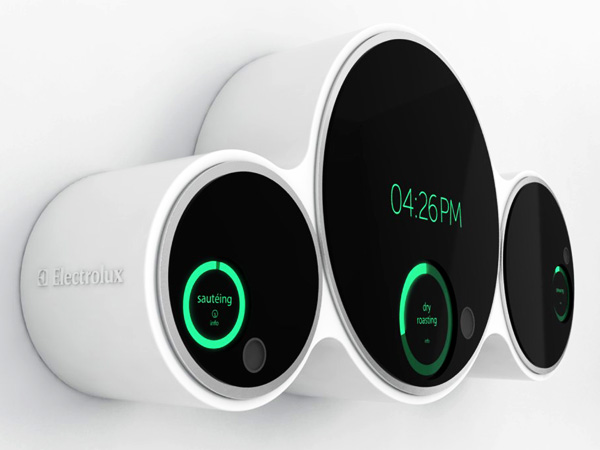
The art of slow cooking requires a lot of patience and given the current time constraints, the present generation cannot afford to indulge in this. The Sous-vide Cell Cooker brings back this art form with a modern twist, where you can control the temperature and cooking styles remotely from cellphone. You can even plan the entire week’s cooking in advance that the intelligent cooker helps you with details like ingredients and precise control of cooking.
Takeaway Steward by Hatao Qin
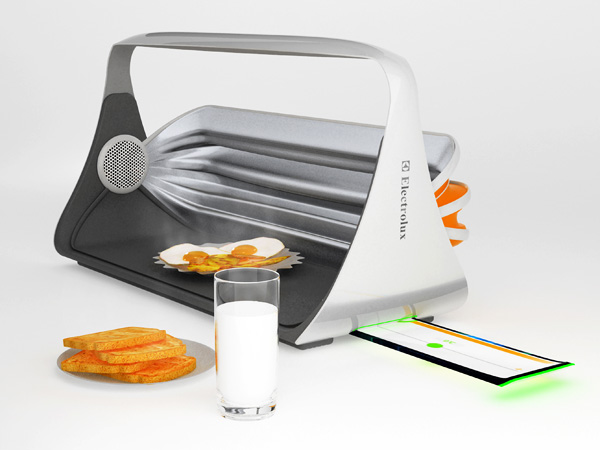
If you love to order take-away but can’t keep up to the delivery times, then this postbox-esque system is right for you. Integrated online meal orders get delivered into your Takeaway Steward, and kept fresh till you retrieve it. Solar panels on the outside power the system and keep it running.
Warm N Cold by François Hurtaud
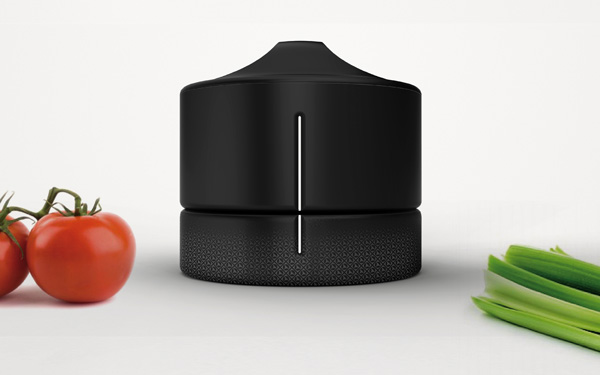
Warm N Cold is storage box with dual functionalities. A part of it works like a fridge to keep the food cold and a little box-switching later, the container functions like a microwave to heat the food. Thermo-electric batteries are used for the job, and the system looks pretty neat overall!
Wave by Kim Min Seok
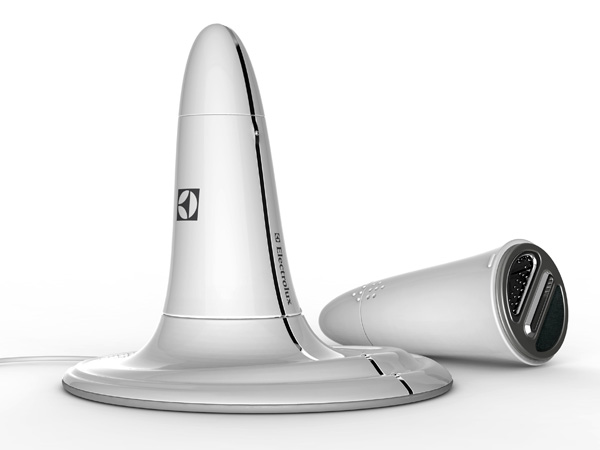
Wave is basically a washing machine assistant that reduces the stains on clothes in a prewash state. It uses ultrasound, hot air and water to remove stubborn stains on clothes before they can be dumped into the machine. This process reduces the stress on the machines when tackling larger loads and help in saving water and resources in the long run.
----------
Yanko Design
Timeless Designs - Explore wonderful concepts from around the world!
Yanko Design Store - We are about more than just concepts. See what's hot at the YD Store!
HP's EcoPOD is the world's most energy efficient data center
by: Ecofriend, 2011-06-13 05:43:12 UTC
Vibhu Sharma:

HP EcoPODWorld’s most energy efficient data center
HP, one of the global leaders in providing efficient and state-of-the-art digital instruments to make your work easy and smooth, announces to launch a modular data center “Performance Optimized Data Center (Pod)” with a claimed power usage efficiency of 1.05. A PUE of 1 shows perfect efficiency. The industry average for data center efficiency is around 2. However some competitors like Microsoft and Google have achieved an efficiency level of 1.14, so it is a big achievement for HP to obtain such a low efficiency level.
This newly developed data center boasts faster deployment with nearly perfect efficiency and 95 percent less energy consumption. It packs 10 times IT capacity in its compact and modular design. HP’s EcoPODs contain 10,000 modules capable of holding 4,400 servers. However, with the usage requirement the energy consumption of data center varies. Most of the energy is consumed in cooling the servers. So, the more are the number of servers, the more is energy consumption. One official from HP says, “it is using hot-cold aisle cooling technology and that the modules are capable of using outside-air cooling to reduce energy consumption as much as possible.” So, if there is enough cold air available outside, the energy consumption will reduce.
GreenBiz claims it to be available for $8 million but the advantages make it worthy of its cost. As IT is the core to all operations, so building efficiency is the key to smooth and productive operations in an organization. Keeping in view all the benefits it provides to organization, this is relatively affordable investment.
Via: Treehugger


 Student-designed bicycle device designed to save lives
Student-designed bicycle device designed to save lives
by: Gizmag Emerging Technology Magazine, 2011-06-10 21:22:44 UTC

Many people are afraid of riding their bicycles on busy roads full of motorized vehicles, and it's easy to understand why. Not only are bikes slower and offer less protection than cars, but they can also be more difficult for drivers to notice. A device invented by a British design student, however, could help level the playing field a little. It's called BLAZE, and it alerts drivers to the presence of a cyclist by projecting a laser image onto the road in front of the bicycle...
Continue Reading
Student-designed bicycle device designed to save livesTags: Accidents,
Bicycles,
Laser,
Road Safety,
Traffic
Related Articles:


 A Look at What's Inside Malt-O-Meal's Sustainability Bag
A Look at What's Inside Malt-O-Meal's Sustainability Bag
by: Greener Design, 2011-06-06 11:45:00 UTC
The cereal company has used its years of cost-based efficiency as it develops its sustainability focus.

 What Does Timberland's $2B Sale Mean for Apparel's Sustainability?
What Does Timberland's $2B Sale Mean for Apparel's Sustainability?
by: Greener Design, 2011-06-13 21:40:15 UTC
Clothing and outdoor gear brand owner VF Corp. bets big on Timberland with $2 billion purchase.

 "99 Design Innovations for Efficient LED Light" video
"99 Design Innovations for Efficient LED Light" video
by: Core77, 2011-06-13 22:30:00 UTC

Lighting design professor, researcher and expert Thomas Schielke has collected ten years' worth of LED designs and developments and put them all together in one video:
The video timeline covers a fascinating selection of the first LED luminaries for interior lighting. The first decade with white LED light reveals how designers have implemented new technology in existing housing, added LED as part of a product group or created a unique design specifically for LED. State-of-the art LED technology requires just about one third of energy for the same lumen output if compared to low-voltage tungsten lamps, thereby enabling task lights for offices with less than 10W. The timeline includes international designers and architects like Norman Foster or Yves Behar as well as new products from the recent Euroluce.
(more...)


 One designer's look at the 2015 Toyota Prius
One designer's look at the 2015 Toyota Prius
by: Gizmodo , 2011-06-13 21:33:43 UTC
What will the next generation of the Toyota Prius look like? Industrial designer Eric Leong gives us a glimpse.
Originally posted at The Car Tech blog
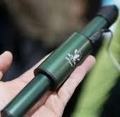









Comments by our Users
Be the first to write a comment for this item.